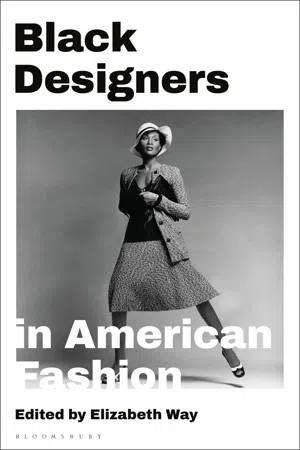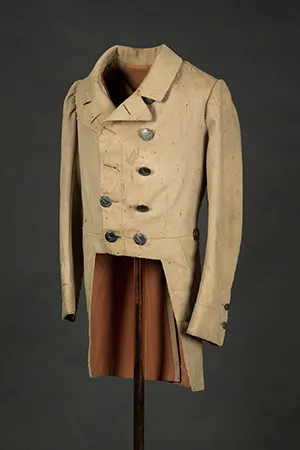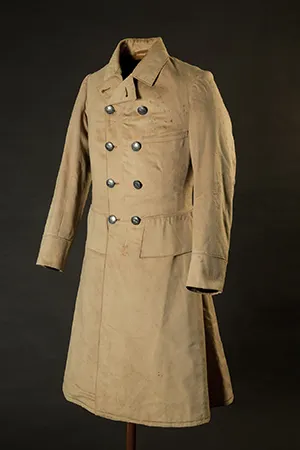
- 288 pages
- English
- ePUB (mobile friendly)
- Available on iOS & Android
eBook - ePub
Black Designers in American Fashion
About this book
From Elizabeth Keckly's designs as a freewoman for Abraham Lincoln's wife to flamboyant clothing showcased by Patrick Kelly in Paris, Black designers have made major contributions to American fashion. However, many of their achievements have gone unrecognized. This book, inspired by the award-winning exhibition at the Museum at FIT, uncovers hidden histories of Black designers at a time when conversations about representation and racialized experiences in the fashion industry have reached all-time highs.
In chapters from leading and up-and-coming authors and curators, Black Designers in American Fashion uses previously unexplored sources to show how Black designers helped build America's global fashion reputation. From enslaved 18th-century dressmakers to 20th-century "star" designers, via independent modistes and Seventh Avenue workers, the book traces the changing experiences of Black designers under conditions such as slavery, segregation, and the Civil Rights Movement. Black Designers in American Fashion shows that within these contexts Black designers maintained multifaceted practices which continue to influence American and global style today.
Interweaving fashion design and American cultural history, this book fills critical gaps in the history of fashion and offers insights and context to students of fashion, design, and American and African American history and culture.
In chapters from leading and up-and-coming authors and curators, Black Designers in American Fashion uses previously unexplored sources to show how Black designers helped build America's global fashion reputation. From enslaved 18th-century dressmakers to 20th-century "star" designers, via independent modistes and Seventh Avenue workers, the book traces the changing experiences of Black designers under conditions such as slavery, segregation, and the Civil Rights Movement. Black Designers in American Fashion shows that within these contexts Black designers maintained multifaceted practices which continue to influence American and global style today.
Interweaving fashion design and American cultural history, this book fills critical gaps in the history of fashion and offers insights and context to students of fashion, design, and American and African American history and culture.
Frequently asked questions
Yes, you can cancel anytime from the Subscription tab in your account settings on the Perlego website. Your subscription will stay active until the end of your current billing period. Learn how to cancel your subscription.
No, books cannot be downloaded as external files, such as PDFs, for use outside of Perlego. However, you can download books within the Perlego app for offline reading on mobile or tablet. Learn more here.
Perlego offers two plans: Essential and Complete
- Essential is ideal for learners and professionals who enjoy exploring a wide range of subjects. Access the Essential Library with 800,000+ trusted titles and best-sellers across business, personal growth, and the humanities. Includes unlimited reading time and Standard Read Aloud voice.
- Complete: Perfect for advanced learners and researchers needing full, unrestricted access. Unlock 1.4M+ books across hundreds of subjects, including academic and specialized titles. The Complete Plan also includes advanced features like Premium Read Aloud and Research Assistant.
We are an online textbook subscription service, where you can get access to an entire online library for less than the price of a single book per month. With over 1 million books across 1000+ topics, we’ve got you covered! Learn more here.
Look out for the read-aloud symbol on your next book to see if you can listen to it. The read-aloud tool reads text aloud for you, highlighting the text as it is being read. You can pause it, speed it up and slow it down. Learn more here.
Yes! You can use the Perlego app on both iOS or Android devices to read anytime, anywhere — even offline. Perfect for commutes or when you’re on the go.
Please note we cannot support devices running on iOS 13 and Android 7 or earlier. Learn more about using the app.
Please note we cannot support devices running on iOS 13 and Android 7 or earlier. Learn more about using the app.
Yes, you can access Black Designers in American Fashion by Elizabeth Way in PDF and/or ePUB format, as well as other popular books in Design & Fashion Design. We have over one million books available in our catalogue for you to explore.
Information
Section 1
Anonymous Histories
1
The Fabric of Fast Fashion: Enslaved Wearers and Makers as Designers in the American Fashion System
On June 1, 1830, Lucy Ann Brown was taken to the Baltimore jail as a runaway. She was wearing “a green bonnet, a common cotton shawl, a red plaid frock, a blue and yellow plaid apron” but “no shoes or stockings.”1 Sources such as this runaway slave advertisement, taken out by enslavers to help track down and reclaim enslaved people who escaped their bondage, reveal a visualization of slavery, demonstrating that the everyday wear of enslaved Southerners in the antebellum period was highly individualized and comprised a multitude of fabrics, colors, and styles. By providing low quality and limited wardrobes to enslaved people, enslavers created a code of dress that was meant to mark enslaved people as outsiders. Although many runaway advertisements list quite a quantity and variety of clothing worn by enslaved people, such as the description of Brown’s apparel, other advertisements speak of desperate conditions. One advertisement, which gave no name for the thirty-year-old man who freed himself in Virginia in the late spring of 1852, noted that “his clothes were so filthy and tattered that their color cannot be known.”2 The jailor who incarcerated Jacob as a runaway did not even attempt to explain Jacob’s apparel, stating simply that his “clothing [was] so much worn out that a description cannot be given.”3 Yet, enslaved people manipulated and supplemented the clothing allowance provided to them. During the antebellum period, enslaved people designed alternative dress codes that were usually misunderstood, unacknowledged, or appropriated by the dominant American fashion system. Necessity created by limited access to quality apparel inspired enslaved people to design new methods of expressing fashionability. Enslaved fashion creators seized opportunities to assert their personal identities and tastes.
When Lucy Ann Brown was jailed in Baltimore, she wore a riot of colors and patterns in her clothing. The blue and yellow plaid apron she wore over her red plaid frock presented a clashing palette of brightness. She covered her head with a green bonnet, but her feet had nothing to protect them. Her ensemble is both typical of the everyday clothing worn by enslaved people, and uniquely styled to her own personality. Brown’s limited access to apparel marked her as an outsider in mainstream American fashion culture. Her lack of footwear speaks to the conditions of enslavement that reflect the domination and suffering of enslaved people’s lived experiences, but her color combination choices demonstrate the pleasure she took for herself in styling her appearance.4
Designers and the Fashion System
The goals of enslavers in using clothing to dominate and cause suffering to enslaved people created tension with the ways enslaved people found pleasure within their everyday dress practices. This fraught relationship provides a complex understanding of how enslaved people affected the early American fashion system. To fully appreciate their contributions requires a reframing of terminology. In the past decade, fashion studies has shifted as a field toward a more inclusive and more accurate consideration of fashion as “changing styles of dress accepted by a group of people, at a specific time, and in a specific place.”5 This definition, developed by Linda Welters and Abby Lillethun, does not limit the phenomenon of fashion to Western Europe and North America, nor to only capitalistic societies. They further define the social phenomenon of a fashion system as “a process of innovation in dress and appearance practices, and diffusion to others.”6 Multiple fashion systems exist in a single place and time, dependent on the relational identities of individuals within a social power system. In the antebellum United States, fashion systems operated simultaneously at global, national, regional, and local levels. In each of these settings, the social identities of people were both defined by others and self-determined through fashion.
Enslaved Americans affected changes in fashion from the micro level of a single rural plantation to the macro level of global industrialization. Recognition of their contributions requires a reframing and redefinition of the term and role of the designer. Traditionally, the term designer is used in reference to the creative maker of innovative apparel that is then adopted by society to become the next fashionable garment, style, or silhouette. But this limited concept of apparel designers as the only innovators does not align with expanding definitions of fashion and how it changes. This chapter argues that designers are indeed the innovators that drive changes in fashion systems. However, the people who develop products used to make apparel, and who use textiles and clothing to stylize existing apparel in inventive ways, should also be considered as designers. Rivana Boynton’s recollection of the methods enslaved women used to achieve the mainstream fashionable silhouette of the 1850s cage crinoline is one example of fashion design through resourcefulness and improvisation: “My missus, she made me a pair of hoops, or I guess she bought it, but some of the slaves took thin limbs from trees and made their hoops. Others made them out of stiff paper and others would starch their skirts stiff with rice starch to make their skirts stand way out.”7
As wearers and makers, enslaved people were at the forefront of the nascent modern American fashion system that began to develop during the late eighteenth century and was solidifying its position by the mid-1800s. The patterns of consumption and approaches to wearing textiles and clothing that ultimately became what is today called fast fashion were first experienced by enslaved people. By expanding the history of the rise of fast fashion much further back than the standard narrative of its birth during the 1960s, it is evident that enslaved people were also implementing the tools of resistance that are resurfacing in the early twenty-first century to combat a fashion system driven by poor quality, ill-fitting, impersonal products.8 When Sylvia Cannon was not provided with warm undergarments for the winter, she made a “petticoat out of old dress an patch en patch till couldn’ tell which place weave.”9 Her description of a repurposed dress so heavily patched that the original parts could not be distinguished from the added scraps is an example of visible mending. In her case, the need for winter clothing resulted in a moment for self-expression and individualization.
Industrialization aided enslavers and others invested in a racially exclusionary American fashion system by promoting the mass production of fabrics and ready-made clothing. Enslaved people were at the center of the shift from older, slower methods of textile-making and use that prioritized long-lasting fabrics and made-to-measure fit, to the current system that encourages producing fabrics that do not last (thus driving the need for an ever-increasing purchasing cycle) and clothing constructed according to ranges of size rather than individual bodies.
Enslaved people negotiated a space within these shifting fashion systems, forging new ways of self-expression while experiencing the gradual loss of direct knowledge of making textiles and clothing. By recognizing the experiences of enslaved makers and wearers, this chapter reveals the importance of Black style and culture to the current fashion industry. Enslaved Southerners in the antebellum United States were among the first people to experience the wearing of standard-sized clothing and disposable fabrics. This chapter presents extant objects and supporting archival evidence centered on the use of ready-to-wear tailored menswear and homemaking practices, including the making of cloth and dyestuffs. Understanding how enslaved people designed space for their bodies through clothing centers them in this historical moment and within the longer history of the modern American fashion system.
The Roots of Ready-to-Wear
Willis Woodsen, describing his job as a carriage footman, remembered that his enslaver “got me a uniform, most like a soldier’s uniform, ceptin mine was red, wid black stripes down de sides … I wore my red suit when I went to church wid de white folks, and held de horses, while dey listened to do sermon.”10 Woodsen’s comparison of his livery to a military uniform speaks to his sense of importance when dressed in the garb of a footman. Livery, worn by servants both free and enslaved throughout the United States during the nineteenth century, did indeed harken back to military uniforms because both relied upon styles that were popular during the late eighteenth century but had long since gone out of fashion.
Woodsen’s livery coat was probably similar to one that was used by a man enslaved by Dr. William Newton Mercer in Louisiana, and that is now part of the Historic New Orleans Collection.11 The livery coat is one of two Brooks Brothers coats purchased by Mercer for men he enslaved. The dark tan fulled wool coats were likely purchased by Mercer in 1858 during one of his many trips to New York City, where he bought plantation tools and bulk purchases of cloth and “negro shoes” each year in addition to expensive wines and luxury goods for his own use.12

Figure 1.1 Brooks Brothers. Livery coat, circa 1860. Wool, linen, cotton, and metal. The Historic New Orleans Collection, 2013.0115.1.
Only one of the coats, a frock coat, has a Brooks Brothers brand label in it, but both were made with similar lining materials and construction methods, though the frock coat is of a slightly higher quality wool than the livery coat. The label for Brooks Brothers of New York, a firm that was known for its men’s tailored clothing, in the interior collar of the frock coat is an early example of the branded labeling of ready-made clothing. The firm began selling ready-made suits in 1849 and changed the name to Brooks Brothers in 1850.13 The buttons on the coats are decorated with a raised design of a bird, said to be the Mercer family crest.14 The enslaved men who wore these coats clearly did important work for Mercer, and their bodies were marked as belonging to the Mercer family through the wearing of similar looking apparel embellished with the same buttons.

Figure 1.2 Brooks Brothers. Frock coat, circa 1860. Wool, linen, cotton, and metal. The Historic New Orleans Collection, 2013.0138.
These coats represent a newer way of purchasing fitted, tailored clothing that was used by lower and working-class people in addition to enslavers. In buying them, Mercer was exercising his ability to consume goods sourced in a far-off metropolitan city in the North. He also used the coats to identify the bodies of the enslaved men who wore them as belonging to him—a uniform that signified to others that he had the monetary capital to own people and to clothe them well—thus increasing his cultural capital as a man of wealth and prestige. The value of well-clothed enslaved bodies served to indicate to other enslavers that certain enslaved bodies belonged to particular persons of impo...
Table of contents
- Cover
- Halftitle Page
- Title Page
- Contents
- List of Illustrations
- Notes on Contributors
- Acknowledgments
- Introduction
- Section 1 Anonymous Histories
- Section 2 In the Atelier: Modistes and Independent Designers
- Section 3 Into the Mainstream: Seventh Avenue and Beyond
- Section 4 The Star Designer: National and International Impact
- Postscript
- Index
- Imprint